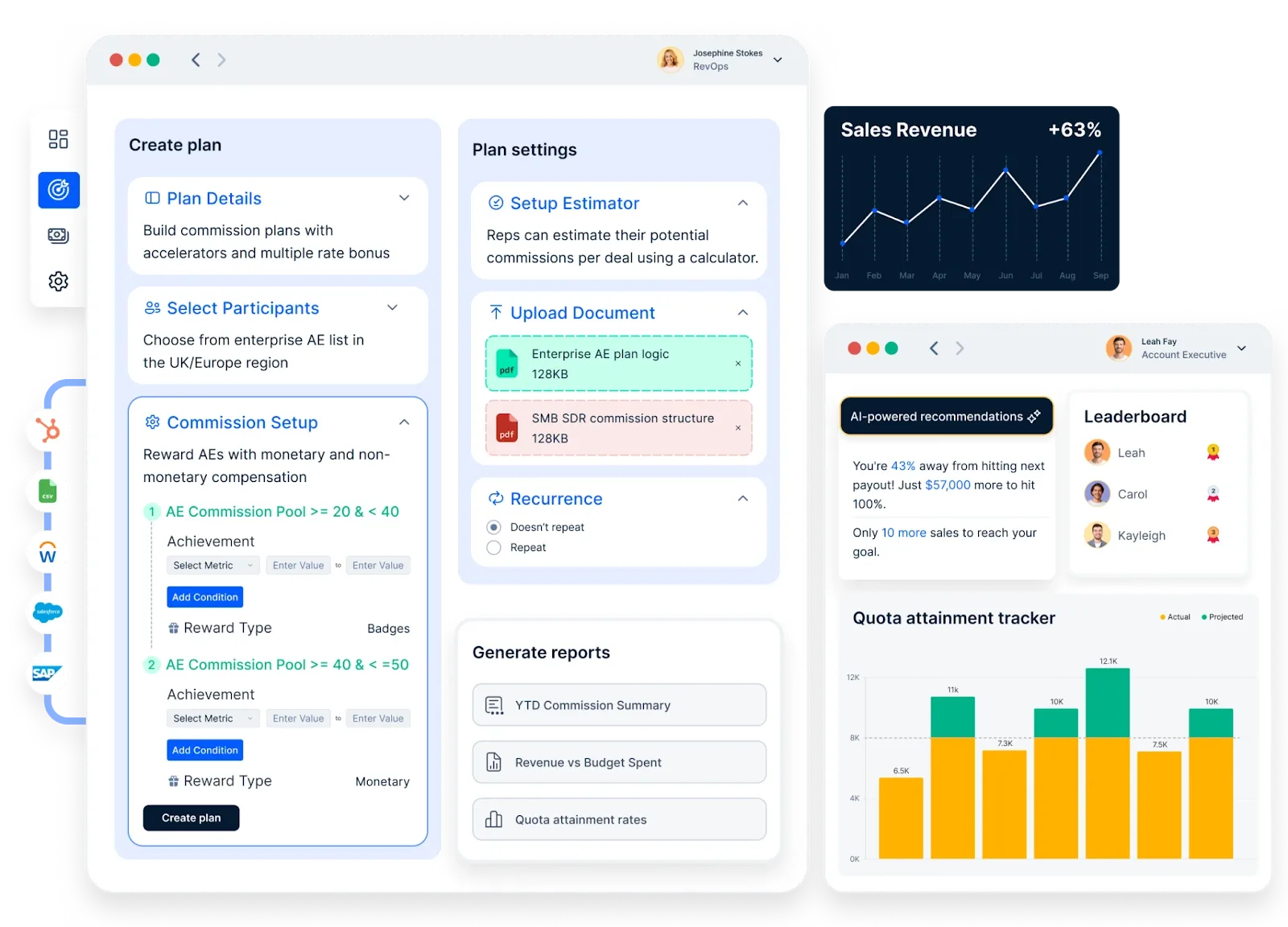En esta página
Una estructura de comisiones bien diseñada puede ser la clave para impulsar el éxito de su equipo de ventas. Cuando se dispone de la estructura adecuada, se atrae a los mejores talentos, motivados para cerrar acuerdos y obtener resultados constantes.
Por otro lado, un plan de comisiones mal estructurado puede provocar una alta rotación, ya que sus mejores vendedores podrían buscar mejores oportunidades en otro lugar. Esto es muy real y quita el sueño a innumerables jefes de ventas. Ainforme de 2018 elaborado por Bridge Groupmuestra que la permanencia media de un representante de ventas es de solo 1,5 años.
En este artículo, analizaremos qué es una estructura de comisiones de ventas, le mostraremos los distintos tipos de estructuras de comisiones de ventas y le daremos consejos sobre cómo estructurar planes de comisiones de ventas de forma eficaz.
¿Qué es una estructura de comisiones de ventas?
Una estructura de comisiones de ventas suele esbozar la forma en que una empresa pagará a sus vendedores y la cantidad que abonará por cada venta. Esto viene determinado por varios factores, como las asignaciones presupuestarias de la empresa para comisiones, los salarios base, los distintos niveles de rendimiento de ventas, los productos que vende una empresa, el sector al que pertenece y otros incentivos incorporados a los planes de compensación.
Las estructuras de comisiones desempeñan un papel clave en la motivación de los empleados para alcanzar objetivos que repercuten directamente en el éxito de una organización.
¿Por qué son cruciales las estructuras de comisiones para su equipo de ventas?
Una estructura de comisiones bien diseñada puede tener un impacto significativo en el rendimiento de su organización. No sólo impulsa la motivación del equipo de ventas, sino que también establece expectativas claras, fomentando una cultura de alto rendimiento. Al alinear los incentivos con los objetivos empresariales, una buena estructura de comisiones ayuda a garantizar que su equipo trabaja para alcanzar los objetivos correctos.
Además, una estructura de comisiones de ventas cuidadosamente elaborada desempeña un papel esencial a la hora de atraer a los mejores talentos y retener a los profesionales de alto rendimiento dentro de su equipo de ventas.
Sin embargo, seleccionar la mejor estructura de comisiones de ventas puede ser complejo debido a los múltiples factores que intervienen. Desde comprender las diferentes estructuras de comisiones de ventas hasta saber cómo estructurarlas de forma eficaz, es importante personalizar el enfoque en función de las necesidades y objetivos específicos de la empresa.
8 tipos de planes/estructuras de comisiones de ventas con fórmulas y ejemplos
Tanto si está intentando averiguar cómo estructurar las comisiones de ventas para su equipo como si desea perfeccionar un plan existente, este desglose le ayudará a tomar decisiones con conocimiento de causa.
1. Sueldo base + comisión
Esta estructura combina un salario fijo con una comisión variable basada en el rendimiento de las ventas. Proporciona estabilidad financiera a los representantes de ventas al tiempo que les incentiva a cerrar tratos.
Ventajas:
- Proporciona seguridad con unos ingresos estables.
- Anima a los representantes de ventas a esforzarse por obtener mayores ingresos.
- Ayuda a las empresas a retener a los mejores talentos.
Remuneración total = Salario base + (Ingresos por ventas × Tasa de comisión)
Ejemplo:
Un representante de ventas con un salario base de 40.000 $ y una tasa de comisión del 10% que genera 200.000 $ en ventas ganaría: $40,000 + ($200,000 × 10%) = $60,000.
Para desglosarlo aún más, el representante de ventas gana un salario base garantizado de 40.000 $ al año. Si generan 200.000 dólares en ventas, reciben 20.000 dólares más en comisiones, con lo que sus ingresos totales ascienden a 60.000 dólares. Esta estructura ofrece un equilibrio entre estabilidad y motivación para vender más.
2. Sólo Comisión
En este modelo, los representantes de ventas obtienen ingresos únicamente de las comisiones, sin salario base. Es habitual en sectores con artículos muy caros o en funciones de ventas empresariales.
Ventajas:
- Muy orientado al rendimiento.
- Reduce los costes fijos de las empresas.
- Motiva a los profesionales de ventas para maximizar los ingresos.
Remuneración total = Ingresos por ventas × Tasa de comisión
Ejemplo:
Un representante con una tasa de comisión del 15% que vende productos por valor de 100.000 $ gana: 100.000 $ × 15% = 15.000 $.
Por ejemplo, si un agente inmobiliario sigue este modelo y vende una casa por 500.000 $ con una tasa de comisión del 3%, sus ingresos por esta venta serían de 15.000 $. Sin embargo, si no cierra ningún trato, no gana nada, lo que hace que esta estructura esté muy orientada al rendimiento, pero también es más arriesgada.
3. Comisión escalonada
Esta estructura recompensa a los comerciales con comisiones más elevadas a medida que alcanzan determinados umbrales de ventas.
Ventajas:
- Fomenta un mayor volumen de ventas.
- Recompensa a los mejores.
- Proporciona una vía clara para el crecimiento de los beneficios.
Remuneración total = (Ingresos por ventas × Tasa de comisión) (para cada nivel)
Ejemplo:
- 5% de comisión sobre las ventas de hasta 50.000 $
- 7% sobre los siguientes 50.000 $
- 10% sobre las ventas superiores a 100.000 $
Si un representante vende 120.000 $: (50.000 $ × 5%) + (50.000 $ × 7%) + (20.000 $ × 10%) = 3.900 $.
Para mayor claridad, el representante gana 2.500 $ por los primeros 50.000 $, otros 3.500 $ por los siguientes 50.000 $ y 2.000 $ por los 20.000 $ restantes. Esta estructura recompensa los mayores esfuerzos de venta con mejores ingresos.
Para mayor claridad, el representante gana 2.500 $ por los primeros 50.000 $, otros 3.500 $ por los siguientes 50.000 $ y 2.000 $ por los 20.000 $ restantes. Esta estructura recompensa los mayores esfuerzos de venta con mejores ganancias.
4. Empate contra comisión
Esta estructura proporciona un anticipo (sorteo) sobre futuras comisiones, que los representantes de ventas deben devolver a través de sus ingresos.
Ventajas:
- Ofrece apoyo financiero en periodos de escasez.
- Ayuda a los nuevos representantes a aumentar sus ventas.
- Reduce la rotación en sectores con ciclos de venta largos.
Remuneración total = Comisión ganada - Importe del sorteo
Ejemplo:
Si un representante recibe un sorteo de 3.000 $ pero gana 4.000 $ en comisiones, su nómina será de 1.000 $ (4.000 $ - 3.000 $).
Por ejemplo, si un representante de ventas nuevo recibe un cobro garantizado de 2.500 $ al mes, pero sólo gana 1.500 $ en comisiones el primer mes, la empresa cubre el déficit de 1.000 $. Sin embargo, al mes siguiente, si el representante gana 3.500 $, la empresa deduce el déficit anterior y el representante recibe 2.500 $ (3.500 $ - 1.000 $).
5. Comisión de volumen territorial
Los representantes de ventas ganan comisiones en función de las ventas totales generadas en un territorio geográfico específico y no de las ventas individuales.
Ventajas:
- Fomenta el trabajo en equipo y la colaboración.
- Evita la competencia entre representantes de la misma región.
- Ayuda a las empresas a penetrar eficazmente en nuevos mercados.
Remuneración total = Ingresos por ventas en el territorio × Tasa de comisión
Ejemplo:
Si un equipo de ventas en una región genera 500.000 $ en ventas y la tasa de comisión es del 8%, el equipo comparte: 500.000 $ × 8% = 40.000 $.
La parte de cada representante depende de su contribución al volumen total de ventas. Si tres representantes contribuyeran a partes iguales, cada uno ganaría 13.333 $.
6. Comisión residual
Los comerciales siguen ganando comisiones por las ventas recurrentes o las renovaciones de clientes anteriores.
Ventajas:
- Ofrece un potencial de ingresos a largo plazo.
- Anima a los representantes a mantener relaciones con los clientes.
- Ideal para empresas basadas en suscripciones.
Remuneración total = Ingresos recurrentes × Tasa de comisión
Ejemplo:
Un representante de ventas de software que cierra una suscripción mensual de 2.000 $ con una comisión del 10% gana: 2.000 $ × 10% = 200 $ al mes mientras el cliente siga suscrito.
7. Comisión de margen bruto
Las comisiones se calculan en función de los márgenes de beneficio y no de los ingresos totales por ventas.
Ventajas:
- Anima a los representantes a vender productos de mayor margen.
- Alinea los incentivos de ventas con la rentabilidad de la empresa.
- Ayuda a controlar las prácticas de descuento.
Remuneración total = (Ingresos - Costes) × Tasa de comisión
Ejemplo:
Si un representante vende un producto por 5.000 $, pero el coste para la empresa es de 3.000 $, y la tasa de comisión es del 15%, sus ganancias son: ($5,000 - $3,000) × 15% = $300.
8. Comisión multiplicadora
Esta estructura ajusta las comisiones en función de métricas de rendimiento, como la consecución de cuotas o la satisfacción del cliente.
Ventajas:
- Recompensa el rendimiento excesivo.
- Alinea los incentivos con los indicadores clave de rendimiento.
- Anima a los representantes a superar sus objetivos.
Remuneración total = Comisión base × Multiplicador de rendimiento
Ejemplo:
Un representante gana una comisión base del 5%, pero si supera el 120% de su objetivo de ventas, el multiplicador aumenta su comisión en 1,5x: (Ingresos × 5%) × 1,5.
Si el representante genera 100.000 dólares en ventas, sus ganancias aumentan a: ($100,000 × 5%) × 1.5 = $7,500.
Al comprender estas diferentes estructuras de comisiones de ventas, las empresas pueden seleccionar la mejor estructura de comisiones de ventas que se alinee con sus objetivos a la vez que motiva a sus equipos de ventas.
Comisiones de venta medias por sector
Para determinar el porcentaje de comisión de ventas adecuado para su equipo de ventas tendrá que tener en cuenta una serie de factores, como el salario base, la naturaleza de los productos y servicios y el grado de investigación y conocimientos técnicos necesarios.
Aunque no existe una fórmula mágica para conseguirlo, el estudio de la media salarial de su sector puede darle una idea de lo que funciona bien.
- Representante de ventas al por mayor y en el sector manufacturero: 61.660 $
- Agentes de ventas de publicidad: 51.740 $
- Agentes de ventas de seguros: 50.600 $
- Corredores inmobiliarios y agentes de ventas: 50.300 $
- Representantes de ventas, servicios, SAAS, apoyo empresarial, telecomunicaciones, todos los demás: 54.550 $
Asimismo, elsalario medio de los vendedores en el Reino Unido era de 20.865 libras esterlinasyen Australia era de 60.632 dólares australianos.. Según los datos recogidos porGlassdoorel salario medio de un representante de ventas en la India es de 4.30.000 rupias.
Ahora hablemos de cómo estructurar perfectamente la comisión de ventas para no fracasar.
¿Cómo estructurar la comisión de ventas?
Ahora que conoce la importancia de una estructura de comisiones de ventas, los distintos tipos de estructuras y las comisiones de ventas medias en los distintos sectores, es el momento de crear una estructura de ventas para su equipo.
Este proceso requiere una cuidadosa planificación y evaluación de diversos factores, como las metas y objetivos de su empresa, el rendimiento anterior de su equipo de ventas y los métodos que utilizará para calcular las comisiones.
Hemos enumerado los pasos que debe seguir para crear su estructura de comisiones de ventas:
1. Determine el objetivo de su estructura de comisiones de ventas
El objetivo principal de una estructura de comisiones de ventas es ayudarle a alcanzar sus objetivos empresariales. Antes de diseñar sus estructuras de comisiones, es esencial que identifique sus prioridades y evalúe cómo esta estructura puede ayudarle a alcanzar estos objetivos.
Tanto si busca aumentar sus ingresos como el tamaño medio de los acuerdos o el porcentaje de clientes que repiten, situar estos objetivos en el centro de su plan le ayudará a decidir cuál es la mejor forma de compensar a su equipo de ventas de manera que fomente directamente estos objetivos.
Compass proporciona una planificación de incentivos basada en objetivos, lo que le permite alinear las estructuras de comisiones con los objetivos empresariales, ya sea el crecimiento de los ingresos, el aumento del tamaño de los acuerdos o la retención de clientes. Los planes de comisiones personalizables garantizan que las estrategias de compensación apoyen directamente los objetivos de ventas y de la empresa.
2. Determine sus objetivos de retribución
El objetivo de compensación es esencialmente la cantidad total que espera pagar a un vendedor como combinación de salario y comisiones. Variará en función de las responsabilidades de la persona, su antigüedad y las tendencias del sector. La compensación suele estar directamente relacionada con los ingresos que se espera que el vendedor genere para la organización.
Establecer estos objetivos desde el principio le ayudará a crear una estructura de comisiones de ventas que se ajuste a sus objetivos y a los recursos de que dispone.
Establezca y gestione los objetivos de compensación basándose en los puntos de referencia del sector y en el rendimiento de las ventas en el pasado utilizando los conocimientos basados en datos de Compass. Garantice la transparencia de la compensación total automatizando el cálculo de salarios y comisiones, reduciendo las disputas y los errores manuales.
3. Evalúe el rendimiento anterior de su equipo de ventas
Eche un vistazo a las estructuras de comisiones existentes en su organización y evalúe hasta qué punto han sido eficaces en el pasado a la hora de motivar a su equipo de ventas para que rinda mejor y alcance sus objetivos.
Identifique los elementos que han funcionado bien para retenerlos y elimine los que no. Esto garantizará que la nueva estructura de comisiones se base en sus resultados anteriores y ayude a llevar el rendimiento de su equipo al siguiente nivel.
Realice un seguimiento del rendimiento histórico utilizando análisis avanzados y cuadros de mando en tiempo real para ver qué estructuras de comisiones han sido más eficaces. Identifique tendencias en la productividad de las ventas y la motivación de los empleados para perfeccionar los modelos de comisiones.
4. Elija su estructura de comisiones de ventas
En función de sus objetivos, metas de compensación y resultados anteriores, elija una de las seis estructuras de comisiones que hemos enumerado anteriormente y adáptela a las necesidades de su empresa.
De paso, decida también cuándo cobrarán las primas sus vendedores. Ya sea cada vez que el cliente paga o cuando firma un contrato, tus empleados necesitan saber cuándo cobrarán.
Elija entre varios modelos de comisiones (fijas, escalonadas, basadas en beneficios, etc.) y adáptelas a las necesidades de su empresa. Automatice el pago de comisiones en función del cierre de la operación, la recepción del pago u otros criterios predefinidos.
5. Comparta su estructura de comisiones de ventas
Ahora que ha creado su estructura de comisiones de ventas, es el momento de compartirla con su equipo. Asegúrese de que sea clara y fácil de entender. Lo último que quieres de tu estructura de comisiones es que confunda a tu equipo de ventas.
Comunique la estructura a su equipo, explíquele las ideas que se han tenido en cuenta a la hora de diseñarla y establezca expectativas para que sepan qué es lo que quiere que consigan.
Una buena práctica consiste en redactar detalladamente la estructura de comisiones y ponerla a disposición de todos los empleados para que les resulte fácil evaluar su rendimiento y saber a qué atenerse.
Compass proporciona un panel centralizado en el que los representantes de ventas pueden ver su estructura de comisiones, ganancias e incentivos en tiempo real. Las notificaciones e informes automatizados garantizan una comunicación clara y establecen las expectativas adecuadas entre el equipo de ventas.
6. Evalúe y mantenga su estructura de comisiones
Esta estructura es un documento vivo. A medida que su empresa crece, su equipo evoluciona o su estrategia cambia. Tendrá que evaluar y ajustar sus estructuras de comisiones para asegurarse de que siguen siendo pertinentes. Sus empleados seguirán motivados y sus objetivos se seguirán cumpliendo.
Utilice el seguimiento del rendimiento en tiempo real y los conocimientos basados en IA para perfeccionar las estructuras de comisiones a medida que evolucionan las necesidades de la empresa.
Consejos para crear una sólida estructura de comisiones de ventas
1.1. Simplifíquelo: Sus vendedores deben ser capaces de ver su estructura y entender que si hacen A, deberían ganar B.
2. Hazlo bien: Elaborar una estructura de comisiones de ventas es un proceso tedioso, y no querrás hacerlo una y otra vez. No sólo confundirá a su equipo, sino que también repercutirá en el rendimiento de su organización. Cuando se siente a crear su estructura, tómese todo el tiempo que necesite para hacerlo bien a la primera.
3. No fije objetivos poco razonables: Aunque quieras que tu equipo ofrezca su mejor rendimiento, establecer objetivos inalcanzables tiene más probabilidades de desmotivarles.
4. No limite los salarios: Tu estructura de comisiones debería motivar a tus empleados a vender más, y deberías apoyarles si quieren ganar tanto dinero como sea posible gracias a su duro trabajo. Poner un tope a los salarios no solo disminuye su potencial de ingresos, sino que también puede hacer que sus mejores empleados se sientan satisfechos.
Automatizar la estructura de incentivos con Compass

Garantice una estructura de comisiones transparente, automatizada y basada en el rendimiento que mantenga motivados a los equipos de ventas al tiempo que alinea los incentivos con el crecimiento del negocio. Vea cómo Compass puede ayudarle.
Reserve una demostración ahora. https://www.getcompass.ai/book-a-demo
Finalizar con Compass
Crear la estructura de comisiones adecuada es crucial para el éxito de su equipo de ventas. Como se suele decir, bien empezado está medio hecho. Comience con la estructura de comisiones de ventas adecuada y podrá atraer al talento adecuado para su equipo y mantenerlo motivado. Evalúe y ajuste su estructura en función del crecimiento de la empresa y del rendimiento de su equipo para retener el talento adecuado y mantener su crecimiento.
Maximice la productividad y el rendimiento de los equipos de ventas conCompass.
Preguntas frecuentes
1. ¿Cuál es la mejor manera de estructurar las comisiones de venta?
La mejor forma de estructurar las comisiones de ventas suele implicar una estructura de comisiones escalonadas, en la que los representantes de ventas ganan porcentajes más altos a medida que alcanzan hitos de ventas específicos. Esto puede motivar a los mejores vendedores y animarles a cerrar acuerdos más importantes o a superar sus cuotas. Otras estructuras eficaces son el salario base más la comisión, que proporciona seguridad financiera al tiempo que incentiva el rendimiento.
2. ¿Cuál es la comisión justa por venta?
Una comisión justa suele oscilar entre el 5% y el 25%, dependiendo del sector y de la complejidad del proceso de venta. Por ejemplo, las comisiones más bajas pueden aplicarse a productos de gran volumen, mientras que las más altas son típicas de ventas de gran valor o complejas. En última instancia, el porcentaje debe estar en consonancia con los objetivos de la empresa y las normas del mercado.
3. ¿Cuál es una estructura de comisiones razonable?
Una estructura de comisiones razonable podría incluir un salario base más una comisión, lo que ofrece estabilidad e incentivos para el rendimiento. Otras opciones, como las comisiones escalonadas o las comisiones por margen bruto, también pueden ser razonables, ya que recompensan a los representantes de ventas en función de su rendimiento y de la rentabilidad de sus ventas.
4. ¿Qué es la regla 70/30 en ventas?
La regla 70/30 en ventas sugiere que el 70% del tiempo de un vendedor debe dedicarse a actividades de venta, mientras que el 30% restante puede asignarse a tareas administrativas y otras responsabilidades. Esta regla subraya la importancia de centrarse en los esfuerzos de venta directa para maximizar la productividad y la generación de ingresos.













